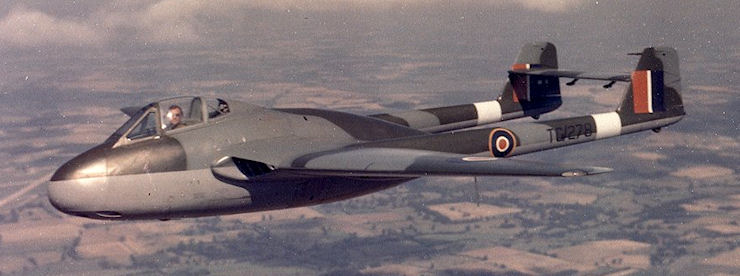

Vampire F Mk. I TG.274
(Goblin I)
Level Speed and Position Error Trials
Summary
| The combat level speed performance of this aircraft and the position error of the pitot-static head have been measured.
The results of the tests showed that, using combat engine conditions of 10,000 rpm and at a weight of 8,180 lb., the maximum level speed which could be attained without exceeding the critical Mach number (0.76) was 526 mph TAS, at 25,500 ft. Above this height it was necessary to throttle back to avoid exceeding this limitation, which arose from deterioration in handling qualities due to compressibility effects. The position error correction varied from +2 mph at 140 mph ASI to +17.5 mph at 480 mph ASI, agreeing approximately with that measured on the prototype Vampire MP.838. The following table shows the maximum level speed together with Mach number and rpm under ICAN conditions for heights from 5,000 to 35,000 ft. for a weight corresponding to 95% of the take-off weight (8,180 lb.). |
| Height | 5,000 | 10,000 | 15,000 | 20,000 | 25,000 | 30,000 | 35,000 |
| TAS mph | 495 | 505 | 513 | 520 | 525 | 516 | 505 |
| Mach No. | 0.660 | 0.686 | 0.710 | 0.734 | 0.756 | 0.756 | 0.760 |
| R.P.M. | 10,000 | 10,000 | 10,000 | 10,000 | 10,000 | 9,900 | 9,710 |
Vampire I TG.274
(Goblin I)
Preliminary handling trials of first
production aircraft
Summary
| General handling trials have been made on the first production Vampire I TG.274, which differed from the prototype aircraft in having a de Havilland Goblin engine of higher maximum thrust.
The trials were made at the typical service loading of 8610 lb. with the centre of gravity position at 6.3 ins. aft of datum (undercarriage up). The results of the tests showed the aircraft to be very pleasant for general flying, but the stick force per 'g' to manoeuvre in the looping plane was considered to be lower than was desirable for a modern fighter. Also, aileron overbalance at high Mach numbers, which was present on the prototype Vampire, was more marked on this aircraft. |
Report No. Aero 2280
Flight tests on the level speed performance of Vampire I
T.G.299 with an investigation into the accuracy of the
thrust measurements.
Summary
| Flight tests have been made on Vampire I T.G.299 to measure its level speed performance.
Engine thrust was measured by means of two jet pipe pitots and from this the aircraft drag coefficient has been obtained up to a Mach Number of 0.77.
An investigation into the method of thrust measurement has shown agreement between measurements from two jet pipe pitot positions to within 2%. However, it is shown that large inaccuracies can arise due to the choking of the final nozzle, if the jet pipe pitot tubes are located very close to the final nozzle. |
| The emphasis in these flight tests has been mainly on the level speed performance of the aircraft and they show that the performance is considerably reduced at high engine R.P.M. due to the large drag increases with Mach Number.
The maximum speed obtainable with a Goblin II engine giving 3,000 lb. sea-level static thrust is 528 m.p.h. at 20,000 ft.
The low Mach Number profile drage coefficient is 0.014 (43.4 lb. at 100 ft./sec.) and the drag has increased by 21% at a Mach Number of 0.77, the highest reached in the tests. It was found that the thrust measurements obtained from the two pitot tubes in the jet pipe agreed to within 2%; large inaccuracies can arise, however, due to the change in the pressure distribution across the final nozzle when the final nozzle choked. |